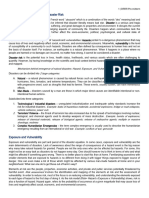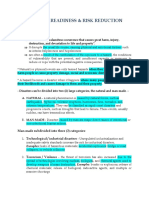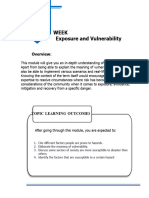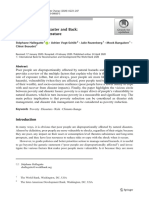0 ratings0% found this document useful (0 votes)
15 viewsExposure and Vulnerability
Exposure and Vulnerability
Uploaded by
Adrian Grafe Lugo Considering social, environmental, and economic factors is important for disaster preparation and risk reduction because it helps identify vulnerable groups and assets that are most at risk. Addressing vulnerabilities can help minimize disaster impacts on people's lives, livelihoods, and the surrounding environment. A holistic understanding of exposure and vulnerability across these different dimensions leads to more effective and equitable disaster risk management.
Copyright:
© All Rights Reserved
Available Formats
Download as PPTX, PDF, TXT or read online from Scribd
Exposure and Vulnerability
Exposure and Vulnerability
Uploaded by
Adrian Grafe Lugo0 ratings0% found this document useful (0 votes)
15 views10 pages Considering social, environmental, and economic factors is important for disaster preparation and risk reduction because it helps identify vulnerable groups and assets that are most at risk. Addressing vulnerabilities can help minimize disaster impacts on people's lives, livelihoods, and the surrounding environment. A holistic understanding of exposure and vulnerability across these different dimensions leads to more effective and equitable disaster risk management.
Original Description:
Disaster Readiness and Risk Reduction Discussion
Original Title
EXPOSURE AND VULNERABILITY
Copyright
© © All Rights Reserved
Available Formats
PPTX, PDF, TXT or read online from Scribd
Share this document
Did you find this document useful?
Is this content inappropriate?
Considering social, environmental, and economic factors is important for disaster preparation and risk reduction because it helps identify vulnerable groups and assets that are most at risk. Addressing vulnerabilities can help minimize disaster impacts on people's lives, livelihoods, and the surrounding environment. A holistic understanding of exposure and vulnerability across these different dimensions leads to more effective and equitable disaster risk management.
Copyright:
© All Rights Reserved
Available Formats
Download as PPTX, PDF, TXT or read online from Scribd
Download as pptx, pdf, or txt
0 ratings0% found this document useful (0 votes)
15 views10 pagesExposure and Vulnerability
Exposure and Vulnerability
Uploaded by
Adrian Grafe Lugo Considering social, environmental, and economic factors is important for disaster preparation and risk reduction because it helps identify vulnerable groups and assets that are most at risk. Addressing vulnerabilities can help minimize disaster impacts on people's lives, livelihoods, and the surrounding environment. A holistic understanding of exposure and vulnerability across these different dimensions leads to more effective and equitable disaster risk management.
Copyright:
© All Rights Reserved
Available Formats
Download as PPTX, PDF, TXT or read online from Scribd
Download as pptx, pdf, or txt
You are on page 1of 10
Chapter 2
Various Element That
May Be Exposed To
Exposed To Hazard:
Environmental, Social and
Economic
EXPOSURE AND
VULNERABILITY
List of 1
2
Describe how vulnerability affect risk:
Distinguish vulnerability from hazard,
Contents 3
exposure disaster risk:
List elements at risk of hazard
4 Determine the vulnerability of exposed
element: and
5 Explain the importance of developing an
inventory of element at risk
Element at Risk and Exposure
Element at risk are the people properties
economic activities and private and public
services potentially threatened by a
harmful event. Risk assessment involves
the identification and mapping of the
elements at risk and the assessments of
vulnerability.
WHAT IS HAZARD AND
EXPOSURE ? HAZARD Refer to the probability of occurrence
at a given magnitude. In next chapter , the subject
of hazards will be discussed in more details.
EXPOSURE elements can refers to the number of
people or structures within the exposed area.
Figures for these two types of elements at risk the
most relabels and least subjective
The combination of both
hazard and exposed
population provides the
physical exposure:
Meaning of the following:
PhExp - Physical exposure for the affected area
Hazard - Probability of occurrence if an event at a
given magnitude.
Exposure - Total population living in the affected
area for each event.
Social, environmental and economic
dimensions of exposure and
vulnerability.
WHEN A DISASTER STRIKES
CASUALTIES . DEATH, MISSING PERSON ,
AND INJURED PEOPLE AND PROPERTY
LOSSSES AND DAMAGES ARE THE FIRST
TO BE REPORTED IN TRIMEDIA.
SOCIAL
Exposure and vulnerability refers to the
characteristics, behaviors, and conditions of
human populations that shape their susceptibility
to the effects of hazards. This includes factors
such as population density, demographic
composition, income level, education, health
status, and social networks. Vulnerable
populations, such as the elderly, children, people
with disabilities, and marginalized groups, often
bear the brunt of disasters due to limited access to
resources, information, and services, as well as
social inequalities and discrimination.
ENVIRONMENTAL
Exposure and vulnerability encompasses the
natural and built environment's characteristics and
conditions that influence the likelihood and
severity of hazard impacts. This includes factors
such as land use patterns, geological features,
ecosystems, biodiversity, climate variability, and
environmental degradation. Environmental
vulnerabilities, such as deforestation, soil erosion,
coastal erosion, and habitat loss, can exacerbate
the impact of hazards and increase communities'
susceptibility to disasters.
ECONOMIC
Exposure and vulnerability relates to the
economic activities, assets, and infrastructure that
are at risk of damage or disruption from hazards.
This includes factors such as income levels,
employment patterns, economic sectors,
infrastructure development, and property values.
Economic vulnerabilities, such as poverty, lack of
insurance coverage, inadequate infrastructure, and
dependence on vulnerable industries, can
exacerbate the social and environmental impacts
of hazards, leading to greater loss and hardship.
ACTIVITY?
Why is it important to consider social,
environmental, and economic factors
when preparing communities for
disasters or challenges?
You might also like
- Quarter 1 - Module 8 Disaster RiskDocument23 pagesQuarter 1 - Module 8 Disaster RiskMC MirandaNo ratings yet
- Reviewer in DRRRDocument4 pagesReviewer in DRRRKate TrespuerNo ratings yet
- VulnerabilityDocument16 pagesVulnerabilityIvan ArcenaNo ratings yet
- DRRR11 Q1 Mod3Document12 pagesDRRR11 Q1 Mod3Lany T. Catamin83% (6)
- Module 1Document35 pagesModule 1Paul Jean MerinoNo ratings yet
- Chapter 2 Summary DRRDocument4 pagesChapter 2 Summary DRRBerch MelendezNo ratings yet
- Concept of Disaster Risk ManagementDocument17 pagesConcept of Disaster Risk ManagementKC CampilanNo ratings yet
- Various Elements That May Be Exposed To Hazards Environmental, Social and EconomicDocument27 pagesVarious Elements That May Be Exposed To Hazards Environmental, Social and EconomicTommy Pascua100% (1)
- Chapter 2 Exposure and VulnerabilityDocument20 pagesChapter 2 Exposure and VulnerabilityJasonNo ratings yet
- SLM 8 Grade1112DRRM 3rd Quarter Disaster Risk NADocument21 pagesSLM 8 Grade1112DRRM 3rd Quarter Disaster Risk NAJudessa Gutierrez BronNo ratings yet
- CORE019_WEEK3-4Document15 pagesCORE019_WEEK3-4efrentomillosoNo ratings yet
- 2 Exposure and VulnerabilityDocument21 pages2 Exposure and VulnerabilityDawn MendezNo ratings yet
- Understanding Disaster and Risk ReductionDocument31 pagesUnderstanding Disaster and Risk ReductionJamillah KanakanNo ratings yet
- DRRR Pre-MidtermDocument5 pagesDRRR Pre-MidtermhjNo ratings yet
- acosta pptx_110750Document64 pagesacosta pptx_110750julitopacilan857No ratings yet
- Disaster Readiness and Risk ReductionDocument19 pagesDisaster Readiness and Risk ReductionandreishioooNo ratings yet
- 2 Exposure and VulnerabilityDocument21 pages2 Exposure and VulnerabilityWendy Dela CruzNo ratings yet
- G1 DRRDocument13 pagesG1 DRRBai Hadriya Quisarta AdilNo ratings yet
- Department of Education: Module in Disaster Readiness and Risk Reduction Grade 12 First Quarter Week 3Document2 pagesDepartment of Education: Module in Disaster Readiness and Risk Reduction Grade 12 First Quarter Week 3Chimmy Changa100% (1)
- DRRR Q1 M3 Exposurevulnerability EmpingDocument12 pagesDRRR Q1 M3 Exposurevulnerability EmpingjuliamaesimbreNo ratings yet
- DRRR ReviewerDocument17 pagesDRRR ReviewerJohn Lloyd RaponNo ratings yet
- DRRR ReviewerDocument12 pagesDRRR ReviewerJohn Lloyd RaponNo ratings yet
- Disaster Readiness and Risk Reduction Lesson 1Document17 pagesDisaster Readiness and Risk Reduction Lesson 1maruhomjohanaaaNo ratings yet
- For Perusal Mod 2Document9 pagesFor Perusal Mod 2ivorygwencheNo ratings yet
- GROUP-3Document25 pagesGROUP-3marcmercado2004No ratings yet
- Vulnerability and RiskDocument2 pagesVulnerability and RiskjaslorNo ratings yet
- DRRR NotesDocument4 pagesDRRR NoteshjNo ratings yet
- DRR11-L2.Exposure and VulnerabilityDocument2 pagesDRR11-L2.Exposure and VulnerabilitySigma ImposiumNo ratings yet
- DRRM HandoutsDocument2 pagesDRRM HandoutsLOSOCON, MARYJOY C.No ratings yet
- Basics-of-Resilience-Risk-disasterDocument21 pagesBasics-of-Resilience-Risk-disastersta.isabelcheyaNo ratings yet
- Module 8 DRRRDocument17 pagesModule 8 DRRRLei Ann SaplacoNo ratings yet
- DRRM Module 1Document10 pagesDRRM Module 1elma anacletoNo ratings yet
- DRRR Week 4 Lesson 2 Hazards Exposure and Vulnerabilities and Their RelationshipDocument10 pagesDRRR Week 4 Lesson 2 Hazards Exposure and Vulnerabilities and Their Relationshipayesha iris matillaNo ratings yet
- Student Copy DRRR Week3 4thQtr 08 June 2021Document16 pagesStudent Copy DRRR Week3 4thQtr 08 June 2021Margaret NicoleNo ratings yet
- Basics of Resilience - Module 1 Study GuideDocument21 pagesBasics of Resilience - Module 1 Study GuideElle Jay Sy100% (1)
- DRRR-M2-4Document79 pagesDRRR-M2-4adalid.briannahlouise3No ratings yet
- Reviewer in DRRR ImrmDocument7 pagesReviewer in DRRR ImrmIrish MaireignNo ratings yet
- DRRR Lesson 1Document32 pagesDRRR Lesson 1Lica BiñasNo ratings yet
- Reporting Soft Copy Bawal Tamad HeheDocument5 pagesReporting Soft Copy Bawal Tamad Hehelean garciaNo ratings yet
- DRM Week2Document9 pagesDRM Week2Lalaine LuzaNo ratings yet
- Appendix B. Basic Concepts in Understanding A DisasterDocument15 pagesAppendix B. Basic Concepts in Understanding A DisasterLany T. CataminNo ratings yet
- DRRM Study Guide - SampleDocument11 pagesDRRM Study Guide - SampleDen Angelica DungoNo ratings yet
- Disaster Vulnerability, Risk and Capacity: Md. Inzamul Haque SazalDocument18 pagesDisaster Vulnerability, Risk and Capacity: Md. Inzamul Haque SazaljaslorNo ratings yet
- DRRRM 4 AutosavedDocument34 pagesDRRRM 4 AutosavedMerry sheleneNo ratings yet
- Disaster RiskDocument20 pagesDisaster RiskMariane Orola CaduyacNo ratings yet
- Disaster Mgt. Unit 1Document13 pagesDisaster Mgt. Unit 1mdfaizalam561No ratings yet
- DRRR HLAS Week 2 With AnswerskeyDocument9 pagesDRRR HLAS Week 2 With AnswerskeyDulce J. LuatonNo ratings yet
- DRRR Lesson 1Document31 pagesDRRR Lesson 1Juddielyn GalutanNo ratings yet
- Effects of Hazard, Exposure and Vulnerability To Disaster RisksDocument23 pagesEffects of Hazard, Exposure and Vulnerability To Disaster RisksShanherrol TriaNo ratings yet
- Loilo ST., Zone 5, Bulan, Sorsogon S.Y. 2020-2021Document2 pagesLoilo ST., Zone 5, Bulan, Sorsogon S.Y. 2020-2021Cristina Gillego GalosNo ratings yet
- DRRR-week-1 and 2-Document17 pagesDRRR-week-1 and 2-Zheniceby CabuetelaNo ratings yet
- Report Scied 221Document6 pagesReport Scied 221Christine Lomeda VillaNo ratings yet
- AMA Second Semester For Disaster Readiness and Risk ReductionDocument6 pagesAMA Second Semester For Disaster Readiness and Risk ReductionLord LlenoNo ratings yet
- Chapter 9 Concept of Disaster Risk Reduction and ManagementDocument26 pagesChapter 9 Concept of Disaster Risk Reduction and ManagementJason B. MaloneNo ratings yet
- C. Disaster Risk (3 HRS)Document3 pagesC. Disaster Risk (3 HRS)Jonna Wayne IbanezNo ratings yet
- Exposure & VulnerabilityDocument24 pagesExposure & VulnerabilitySADEZ ZALDYNo ratings yet
- Joey Boy Mission - DRRR - MODULE NEW TEMPLATE - Q1 - M1W1 PDFDocument2 pagesJoey Boy Mission - DRRR - MODULE NEW TEMPLATE - Q1 - M1W1 PDFChimmy Changa100% (1)
- 2 Exposure and VulnerabilityDocument20 pages2 Exposure and Vulnerabilityarmanderico25No ratings yet
- Disaster Vulnerability, Risk and CapacityDocument18 pagesDisaster Vulnerability, Risk and CapacitysazalgeoNo ratings yet
- Constructing Risk: Disaster, Development, and the Built EnvironmentFrom EverandConstructing Risk: Disaster, Development, and the Built EnvironmentNo ratings yet
- SCIENCE-DRRR - Q1 - W4 - Mod1Document16 pagesSCIENCE-DRRR - Q1 - W4 - Mod1Markus Bernabe DaviraNo ratings yet
- Upm DRRMMDocument160 pagesUpm DRRMMQueen Vi BenedictoNo ratings yet
- Hallegatte2020 Article FromPovertyToDisasterAndBackARDocument25 pagesHallegatte2020 Article FromPovertyToDisasterAndBackARKalshan DulanjaNo ratings yet
- Disrupting Harm-Conversations With Young SurvivorsDocument76 pagesDisrupting Harm-Conversations With Young SurvivorssofiabloemNo ratings yet
- Disaster Management PDFDocument186 pagesDisaster Management PDFPreetham Raja67% (3)
- DRRR Exit Exam ReviewDocument28 pagesDRRR Exit Exam ReviewJonn EngueroNo ratings yet
- Structural Adjustment, Urban Systems and Disaster Vulnerability in Developing CountriesDocument9 pagesStructural Adjustment, Urban Systems and Disaster Vulnerability in Developing Countriesmichael17ph2003No ratings yet
- VulnerabilityDocument15 pagesVulnerabilitySofia Nikole De LeonNo ratings yet
- ACCORD Manual Vol 1 Community Based Disaster Risk ManagementDocument106 pagesACCORD Manual Vol 1 Community Based Disaster Risk Managementexo aegiiNo ratings yet
- Cor-010 (Disaster Readiness and Risk Reduction)Document6 pagesCor-010 (Disaster Readiness and Risk Reduction)Armhay Loraine DuavezNo ratings yet
- Disaster ReviewerDocument4 pagesDisaster ReviewerYayoi MiNaNo ratings yet
- Download Full Developmental Psychopathology 1st Edition Amanda Venta PDF All ChaptersDocument40 pagesDownload Full Developmental Psychopathology 1st Edition Amanda Venta PDF All Chapterssambooishani100% (2)
- Disaster Management - Session 7 NotesDocument8 pagesDisaster Management - Session 7 Notesdevesh routNo ratings yet
- Cidam DRRRDocument11 pagesCidam DRRRMarvin BarcelonNo ratings yet
- Recognized by The Government I Founded 1928 I Candelaria, QuezonDocument2 pagesRecognized by The Government I Founded 1928 I Candelaria, QuezonOccasus DeirdreNo ratings yet
- Student Led School Watching and Hazard MappingDocument26 pagesStudent Led School Watching and Hazard MappingVince Cleo ManlimosNo ratings yet
- On Disaster Readiness & Risk Reduction - First Quarter: Table of Specification For A 50 - Item TestDocument4 pagesOn Disaster Readiness & Risk Reduction - First Quarter: Table of Specification For A 50 - Item TestLiezel CauilanNo ratings yet
- Risk Assessment and Its Role in Disaster Risk Reduction and Emergency Management (Heather Bell)Document18 pagesRisk Assessment and Its Role in Disaster Risk Reduction and Emergency Management (Heather Bell)Asean Drr PortalNo ratings yet
- M4 Lecture Notes The DRMAPS Case Study Proposal - Acm - 2122-2Document10 pagesM4 Lecture Notes The DRMAPS Case Study Proposal - Acm - 2122-2Maria VirtzNo ratings yet
- Disaster Management ContinuumDocument10 pagesDisaster Management ContinuumCogie SalvadorNo ratings yet
- MONK MODE 30DAY CHALLENGeDocument20 pagesMONK MODE 30DAY CHALLENGeelkhomsiossamaNo ratings yet
- 1disaster Nursing SAS SessionDocument7 pages1disaster Nursing SAS SessionBeverly Mae Castillo JaymeNo ratings yet
- DRRR - Q1 - Module 1Document13 pagesDRRR - Q1 - Module 1Teacher Charlyn VlogNo ratings yet
- Chapter 2. Exposure and VulnerabilityDocument34 pagesChapter 2. Exposure and VulnerabilityLucas TylerNo ratings yet
- Disaster Risk Reduction in Education in EmergenciesDocument31 pagesDisaster Risk Reduction in Education in EmergenciesBianne Easter GervacioNo ratings yet
- G318 Mod2 RiskAssessmentDocument82 pagesG318 Mod2 RiskAssessmentsdfwefNo ratings yet
- Assessing Climate Change Vulnerabilities of The Waste Management in The West Bank REstructuredDocument109 pagesAssessing Climate Change Vulnerabilities of The Waste Management in The West Bank REstructuredtopqualitywriters2017No ratings yet
- Blumentritt CBDRRMDocument69 pagesBlumentritt CBDRRMbrgyblumentritt2024No ratings yet
- VALORESDocument48 pagesVALORESJorge392No ratings yet
- Daring Greatly Designed PDF Exercises - A4Document25 pagesDaring Greatly Designed PDF Exercises - A4megsdjNo ratings yet

























































































